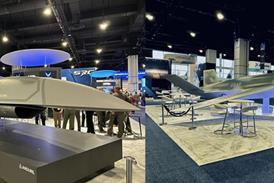Two of the US Air Force’s premier fifth-generation fighters, the Lockheed Martin F-35A Joint Strike Fighter Lightning II and F-22A Raptor, still can’t transmit data back and forth but the service’s plan to fix the communication gap is undetermined.
Today, the F-22’s Link 16 network can only receive data from the F-35. The JSF can both transmit and receive data with other Link 16 legacy aircraft including F-16, F-15 and other NATO aircraft, Brig Gen Scott Pleus, director of the F-35 Integration office tells FlightGlobal.
The F-35 would not receive F-22 data until a fourth to fifth generation gateway is deployed, but the timeline on that gateway is undecided, the service tells FlightGlobal. The USAF has plans for fourth to fifth-generation communications, which would cover the F-22’s Link 16 radio, but they’re not yet programmes of record.
The real crux of the matter is that F-22 — in addition to Link 16 — operates with uses an intra-flight data link (IFDL) to communication within the Raptor fleet, while the F-35 uses both legacy Link 16 and the Multi-Function Advanced Datalink (MADL), Pleus said in a 24 March interview with FlightGlobal.
Both IFDL and MADL have a low-probability of intercept and low-probability of detection capability that fends off jamming and eavesdropping. But the two systems can’t talk to each other in the same way the F-15C and F-22 can communicate using the Talon HATE pod, Pleus says.
“We don’t have anything like that and there’s currently nothing on the books for any testing,” he says.
Pleus argues linkLink 16 was built to share information across multiple aircraft through a secure gateway, something the F-22 and F-35 can achieve through a fusion engine that takes in information and displays it to the pilot on a single screen.
“That information doesn’t necessarily have to be passed through IFDL or through MADL,” he says. “The bigger issue is, can I get that information into fourth-generation fighters?”
The USAF has the technologyability to secretly connect an F-35 flying in defended airspace with an F-15 outside the threat zone, though it requires a web of communications, Pleus says. In one notional scenario, Pleus describes placing multiple F-35s in a line, with the first aircraft deep inside and defended airspace and the last outside the threat zone. The F-35 aircraft is hostile airspace relays critical data, such as targeting information, along the chain of MADL-equipped stealth fighters, until the message reaches an F-35 outside the threat zone, which then relays the data to the F-15 on Link 16.
The air force could string F-35 on MADL and then could transmit “outside the bubble” to the rest of the force on Link 16 while maintaining the LPD network, he says.
Pleus also argues that MADL was never designed to share information in the same way as Link 16. Rather than enable the F-35 to communicate with F-16s or F-22s, the MADL network was designed to display information and give the pilot situational awareness, he says.
Source: FlightGlobal.com























